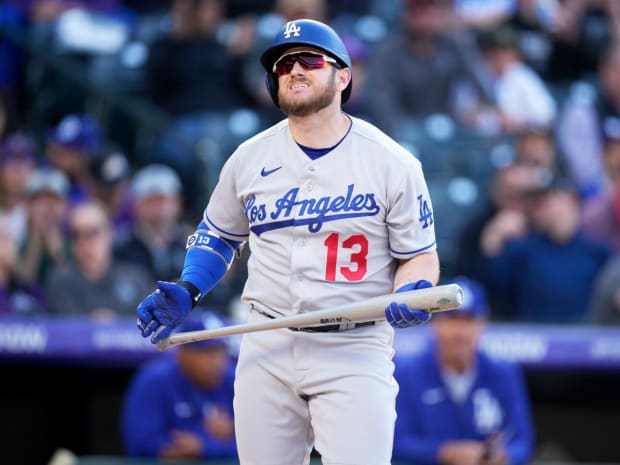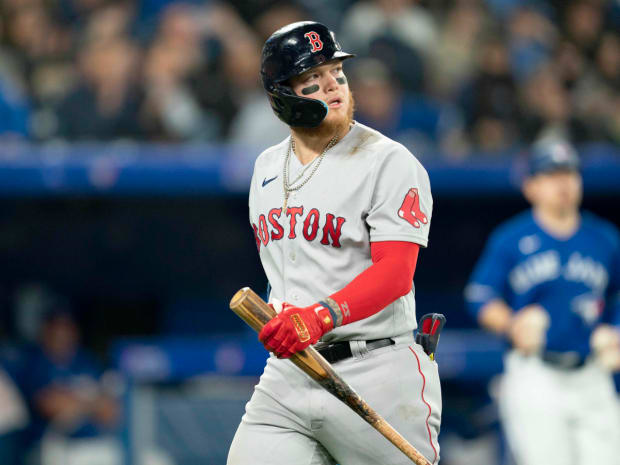View the original article to see embedded media.
Welcome to The Opener, where every weekday morning during the regular season you’ll get a fresh, topical story to start your day from one of SI.com’s MLB writers.
We’re just about a month into the season. The standings and statistics will look a lot differently by the time we get to October, and it’s probably too early for most sweeping generalizations. The old adage is you shouldn’t overreact to anything before Memorial Day, and that holds even more true this season, which started a little later than usual due to CBA negotiations.
At the same time, it’s not too early to react to what we’ve seen on the field so far and recalibrate our expectations for certain teams and players. The Mets already ran out of patience with Robinson Canó, opting Monday to release the multitime PED violator with less than 50 plate appearances under his belt rather than watch him try to battle back above the Mendoza Line. Countless other transactions have been carried out based on less than a month’s worth of results. So you can’t blame fans for getting a little anxious about the players and teams who aren’t performing up to their standards.
I’m here to help those worrywarts either justify their anxiety or calm them down. With the help of the SI MLB Panic Meter, let’s take a look at five position groups or players who have gotten off to slow starts. We’ll diagnose whether their struggles are short-term issues or harbingers of more woes to come.

AP Photo/David Zalubowski
Dodgers IF/DH Max Muncy
When a player comes out of nowhere to morph into an All-Star, there’s a part of me that often wonders whether he’s ready to turn back into a pumpkin at any moment. Max Muncy, though, is not one of those guys who concerns me.
There’s no doubt the former A’s DFA victim has an ugly stat line (.151/.319/.315). It’s never a good thing when your on-base percentage is higher than your slugging percentage. But we’ve seen the 31-year-old go through these sorts of slumps before (see: the entirety of the shortened 2020 regular season) only to suddenly break out of them (see: the ’20 playoffs). Maybe he’s about to go off; he snapped an 0-for-16 skid Wednesday with a 2-for-3 night, including a homer, against the Giants.
Muncy has been a bona fide slugger for almost five years now. He’s a two-time All-Star and has finished in the top 15 of MVP voting in every full season since his emergence with the Dodgers in 2018. There’s a chance he’s still getting into the swing of things after debuting late in spring training due to the elbow injury that kept him out of last year’s playoffs. He also may just be experiencing a bout of horrific luck; his .154 BABIP is fourth-lowest among 174 qualified batters even though he ranks 15th in barrel rate. Also, Muncy’s walk rate (18.7%) still is almost higher than his strikeout rate (19.8%), and his 94 wRC+ indicates he’s been only 6% worse than the average MLB hitter so far despite his relative struggles. Expect him to live up to his middle-of-the-order standards sooner than later and keep the Los Angeles lineup rolling.
Panic level: Snooze button
Atlanta’s outfielders
Much was made of Atlanta’s midseason makeover in the outfield ahead of its World Series run last year, and rightly so. All four of Joc Pederson, Adam Duvall, Eddie Rosario and Jorge Soler contributed signature moments during the 2021 playoffs, with Rosario and Soler earning NLCS MVP and World Series MVP honors, respectively.
The Braves seemed set for solid, if not stellar, production in the outfield this season after retaining Duvall and Rosario to pair with the signing of former Giants left-handed hitter Alex Dickerson and the returns of Ronald Acuña Jr. and Marcell Ozuna. It has not played out that way. While posthype prospect Travis DeMerritte’s emergence as Atlanta’s most productive outfielder is a nice story, the Braves need more than him to successfully defend their crown.
Dickerson has already been designated for assignment after going 4-for-33 with nine strikeouts, three walks and one extra-base hit. Rosario was even worse, going 3-for-44 with two singles, one double and 10 strikeouts before succumbing to eye surgery that should keep him out until after the All-Star break. Ozuna and Duvall haven’t provided enough power to offset their alarmingly low on-base rates. Acuña has yet to launch his first home run and has one extra-base hit in 28 plate appearances since returning from his torn ACL. As a unit, they’ve combined to slash .200/.266/.325 with a 70 wRC+ (25th in MLB) while tying for 28th in defensive runs saved (-5) and last in UZR (-6.3), the two most prevalent defensive metrics. Pederson has added to the sting by setting the world on fire, sans pearl necklace, in San Francisco.
The good news is we’re talking about a position group headlined by a 24-year-old perennial MVP candidate. It’s only a matter of time before Acuña, just six games in, returns to his dynamic form, and his assuming his rightful place in right field on a daily basis should help the pieces fall into place across the board. Duvall and Ozuna have always been streaky hitters, and whatever DeMerritte can contribute would be found money. Top prospect Michael Harris II also looms in the minors as a “break in case of emergency” option. It wouldn’t be shocking to see this unit need another July acquisition, especially if another injury crops up, but it’ll be a while longer before president of baseball operations Alex Anthopoulos starts to think about that.
Panic level: Forgot to go to an ATM for a cash-only food truck, but your friend has you covered.

Nick Turchiaro/USA TODAY Sports
Boston’s offense
Five out of our six baseball writers picked the Red Sox to miss the playoffs this year, so it isn’t exactly surprising that they’re tied for last in the loaded AL East. But the manner in which they’ve ended up there qualifies as a shock to the system.
Boston’s rotation looked like the clear Achilles heel heading into the season. And the bullpen has certainly had its issues. It’s the lineup, though, that’s held the Red Sox back. Their 79 wRC+ ranks 29th in the majors after they graded out as the sixth-best offense last year by the same metric. Thursday’s 8–0 defeat to the Angels marked their first shutout loss at home since Opening Day … of the 2021 season.
J.D. Martinez, Xander Bogaerts and Rafael Devers are the only three batters carrying their weight. Major offseason acquisition Trevor Story has appeared lost at the plate. Travis Shaw did not reach base in any of his 19 plate appearances he was designated for assignment Sunday. Somehow, first baseman Bobby Dalbec has looked even worse at the plate than he did during the first half last year, leaving a black hole at a premium offensive position. Jackie Bradley Jr., Kiké Hernández and Alex Verdugo have been the main culprits in giving Boston the second-worst hitting outfield in the majors (66 wRC+). Teams rarely hit this poorly for an entire month by accident.
The entire ordeal has left the Sox 8.5 games behind the Yankees in the division, tied with the aimless Orioles. Five straight series losses have sunk their playoff odds, per FanGraphs, to 29.7%, down from 63.1% on Opening Day. No team in either league has suffered such a large decrease.
The roster’s pedigree and solid 21.4% strikeout rate, ninth-best in the majors, provide hope that some more batted-ball luck will spark a turnaround. But while the offense should hit its stride in the coming weeks, it’s just as likely that the rotation will experience some negative regression. Michael Wacha won’t remain fourth on the AL ERA leaderboard, and 42-year-old Rich Hill has to lose to Father Time at some point.
Panic level: It’s late, you need to call a ride-share service and your phone is at 2%.
Reds 1B Joey Votto
As the longtime face of the Reds, it would make sense that as Joey Votto goes, so does his team. Well, both have looked more foul than Skyline Chili thus far (sorry, Cincinnatians). The likely future Hall of Famer has responded to speculation about his sharp decline about as well as anyone could, first with a philosophical simile, then a Charlie Brown GIF, then his trademark deadpan sarcasm.
While I applaud and strive toward his Twitter presence, that doesn’t soften the fact that his batted-ball metrics (which he also addressed) are quite ugly at the moment.

via Baseball Savant
Votto ignited a career renaissance last year by adopting a more aggressive mindset at the plate, which resulted in the sacrificing of a bunch of base hits for some home runs. Great! It was the right route to take amid the all-or-nothing offensive era in which we live. Now, though, he’s not accounting for much of either. The six-time All-Star is 9-for-74 on the season with just one extra-base hit (a double) and a .413 OPS that’s third-worst among qualified hitters. He’s also nursing a career-worst mark in strikeout rate while swinging on first pitches and at pitches outside of the zone more often than ever before. Even during his two-season downturn between 2019 and ’20, Votto still ranked in the upper half of MLB hitters in expected batting average and expected slugging percentage. That is no longer the case—far from it, actually.
If anyone can remake his plate approach to better accentuate his evolving strengths and weaknesses, it is Votto, who is one of the most revered hitting scientists in the sport. But he’ll have to work overtime to reinvent himself again at age 38.
Panic level: Your doctor asks you to come back in a few months, just as a precaution.
Cubs SP Kyle Hendricks
It’s always been a little too easy to think of Kyle Hendricks as a poor man’s Greg Maddux. They both came of age with the Cubs. They both built up reputations as command artists who rely on pitching to contact. They’re both respected as deep thinkers of their craft. Their windups are even near mirror images. Hendricks was never going to win four Cy Young awards, but he has a World Series–clinching start on his résumé, and for a while looked like a guy who could hang around deep into his 30s based on guile and pitchability.
But, in terms of cold, hard results, that comparison has started to crumble over the last two seasons (if it wasn’t already outlandish, to begin with). Hendricks has more and more resembled a starter who’s being aged out of the modern game that emphasizes velocity and swing-and-miss stuff.
No one gave up more hits than Hendricks last year, when he posted career worsts across the board. Now, perhaps even more concerning, he’s seemingly lost his calling card: control. His walks per nine innings has more than quadrupled since 2020, when he had the lowest such mark in the majors. The troubling combination of hittability and inaccuracy has resulted in a 5.54 FIP, the worst mark among 63 qualified starters. With batters confronting historically high heat in the batter’s box, facing Hendricks and his hittable, high-80s fastball must feel like a welcome respite. Even the Pirates and Brewers, two of MLB’s 10 worst offenses by wRC+, have teed off on the 32-year-old (his only quality start in six outings also came against Pittsburgh).
The Professor has the leeway to work out his kinks on a Cubs team that wasn’t expected to contend this year. But, aside from his contract that runs through 2024, there are few signs on a personal or league-wide level that indicate he’s long for this league.







